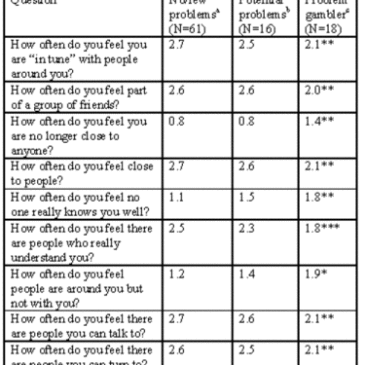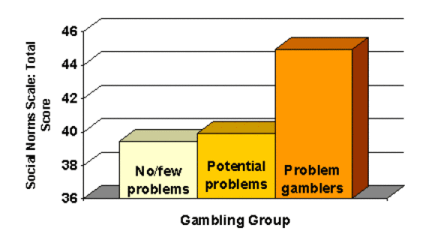Gambling Problems, Relationships and Social Networks
Part 1: Social Networks: Good, Bad or Ugly
Series compiled by:Michael Stanton
Introduction to the Series
Anyone who has ever been affected by addiction, directly or indirectly, understands how integral a role personal relationships play in addiction. Family, friends, and social networks can: (1) initiate addictive behavior, (2) contribute to the development of addiction, (3) suffer as a result of addiction, (4) serve as a protective factor against the development of addition, and (5) influence addiction recovery. The relationship between addiction and social networks can be recursive. For people with gambling problems, feelings of isolation and loneliness sometimes precipitate gambling behavior (e.g., Brown & Coventry, 1997). Gambling problems can also create or exacerbate difficulties in maintaining close personal relationships (e.g., Lorenz & Yaffee, 1988). Clinicians have developed therapies to address these contributing social factors and focus on repairing relationships hurt by gambling problems (e.g., Heineman, 1987).
The few studies that have addressed the associations between gambling problems, relationships and social networks indicate that the development, continuance and recovery from gambling problems all involve social factors and personal relationships. Despite these associations, there is a conspicuous lack of scholarship on the relationship between social networks (e.g., families, friends, co-workers) and gambling problems. Over the next three weeks, the WAGER will present a series on the relationship between gambling problems and social networks. The three WAGERs will review articles that address: 1) the impact of social networks on gambling problems; 2) the impact of gambling problems on close personal relationships; and 3) treatment options that incorporate family and social relationships. Through this short series we will address this important area of gambling research that merits our attention.
Part I – Social Networks: Good, Bad or Ugly?
The quality of relationships with family and friends likely influences the initiation of gambling and its progression to disordered levels. However, though many studies posit such a connection, only a few studies have actually examined whether there is a link between social networks and gambling involvement. These initial studies suggest that loneliness and the experience of family problems might contribute to gambling involvement (Grant & Kim, 2002; Hardoon, Gupta, & Derevensky, 2004; Lesieur & Blume, 1991). In this week’s WAGER, the first of a series on gambling problems, social networks, and relationships, we review a study by Trevorrow and Moore (1998) that compared feelings of loneliness, social networks, and perceived gambling norms between women with and without a gambling problem.
The researchers recruited and surveyed women from Victoria, Australia as they were leaving either electronic gaming machine venues (a location chosen to ensure an adequate sample of frequent gamblers) or recreational and shopping venues. Participants completed: (a) a survey about their gambling behavior, including the South Oaks Gambling Screen (Lesieur & Blume, 1987) to assess problem gambling; (b) the revised UCLA Loneliness Scale (Russel, Peplau, & Cutrona, 1980) to assess feelings of loneliness and satisfaction with social relationships; (c) the Gambling Social Norms Scale (Moore & Ohtsuka, 1997) to assess their perceived acceptance of gambling by friends and family; and (d) questions assessing their social network (measured by friendship satisfaction, partnership status, employment status, and engagement in social/sporting organizations). The researchers distributed 150 surveys; 95 (63.3%) were returned.
Of the 95 women surveyed, 18 (18.9%) women scored above 5 on the SOGS and were classified as problem gamblers; 16 (16.8%) scored between 2 and 4 and were classified as potential problem gamblers; the majority (61, 64.2%) were classified as having none or very few problems.1 Problem gamblers had social networks that were comparable to the other gambling groups with regard to membership (i.e., partnership status, employment status, and engagement in social/sporting organizations) and friendship (i.e., friendship satisfaction, but their feelings of connection to those social networks differed significantly. Overall, problem gamblers scored higher on the Loneliness Scale than either potential problem gamblers or people without gambling problems (M = 25.8, M = 19.1, and M = 17.0, respectively, F(2,92) = 6.78, p < .01).2 As Table 1 illustrates, problem gamblers rated 9 of the 20 items on that scale significantly higher than other groups; the distribution of items indicated they felt more alienated and outside the group than other participants, despite their comparable social networks. Finally, problem gamblers were more likely to be members of social networks with positive social norms for gambling (see Figure 1; F(2,82) = 5.07; p < .01). Specifically, within the Social Norms Scale, problem gamblers rated their friends’ and family members’ involvement in gambling significantly higher than others; reported social network approval of gambling did not differ between groups.
Table. 1 Mean scores for selected questions from the UCLA Loneliness Scale (0=never; 1=rarely; 2=sometimes; 3=often) (adapted from Trevorrow & Moore, 1998).
a score of 0-1 on the SOGS. b score of 2-4 on the SOGS. c score of >4 on the SOGS. *p<.05. **p<.01. ***p<.001
Figure 1. Perception of positive social norms relating to gambling (range: 12 – 60, higher = more positive perception) (adapted from Trevorrow & Moore, 1998).
When interpreting the above results, it is important to remember that the study was cross-sectional in nature. As the authors rightly point out, loneliness and positive social norms surrounding gambling could therefore be a cause or a consequence of problem gambling. The experience of loneliness might drive women to seek comfort or escape in gambling, which heightens their risk of developing problems. Alternatively, loneliness could be a consequence of their gambling problems: as women experience greater problems, they might increasingly feel they do not have friends who can understand their situation. Likewise, social networks in which gambling is normative might encourage gambling initiation and involvement; alternatively as women spend more time gambling they might form new friendships with people who share their interest in gambling. A longitudinal study is needed to elucidate the true causal relationship between these variables. Other limitations to this study include the small sample size, the limited geographic area sampled, and the sole focus on women. Finally, the study used a measure perceived gambling norms; this measure may not reflect actual gambling norms in the social network.
The relationship between problem gambling and the quality of social networks is likely complex. Social networks can exert positive or negative influence depending on the social context and the norms they perpetuate; for example, a street gang provides strong social support but encourages violence among its members. Within the specific context of gambling, Trevorrow and Moore have taken an important first step in highlighting the complex influence of social networks on gambling. Their study suggests that having a strong and supportive social network can be protective if it alleviates loneliness, but it can also be detrimental if group norms encourage behavior that has potential risks, such as gambling.
Comments on this article can be addressed to Rachel Kidman.
Notes
1 Only 5% of the group surveyed at recreational and shopping venues qualified as problem gamblers; 82% from that group had no or few problems with gambling.
2 The authors report running Scheffe comparisons to test specific differences between groups (e.g., problem gamblers compared to all others) and report presence or absence of significance for those comparisons. However, the only statistics provided in the report are the omnibus F-tests comparing all three groups.
References
Brown, S., & Coventry, L. (1997). Queen of hearts: The needs of women with gambling problems. Melbourne: Financial and Consumer Rights Council.
Grant, J. E., & Kim, S. W. (2002). Gender differences in pathological gamblers seeking medication treatment. Comprehensive Psychiatry, 43(1), 56-62.
Hardoon, K., Gupta, R., & Derevensky, J. (2004). Psychosocial Variables Associated With Adolescent Gambling. Psychology of Addictive Behaviors, 18(2), 170179.
Heineman, M. (1987). A comparison: The treatment of wives of alcoholics with the treatment of wives of pathological gamblers. Journal of Gambling Behavior, 3(1), 27-40.
Lesieur, H. R., & Blume, S. B. (1987). The South Oaks Gambling Screen (SOGS): A new instrument for the identification of pathological gamblers. American Journal of Psychiatry, 144(9), 1184-1188.
Lesieur, H. R., & Blume, S. B. (1991). When lady luck loses: Women and compulsive gambling. In N. Van Den Bergh (Ed.), Feminist perspectives on addictions. New York: Springer Publishing Company.
Lorenz, V. C., & Yaffee, R. A. (1988). Pathological gambling: Psychosomatic, emotional and marital difficulties as reported by the spouse. Journal of Gambling Behavior, 4(1), 13-25.
Moore, S. M., & Ohtsuka, K. (1997). Gambling activities of young Australians: Developing a model of behaviour. Journal of Gambling Studies, 13(3), 207-236.
Russel, D., Peplau, L., & Cutrona, S. (1980). The revised UCLA loneliness scale: Concurrent and discriminant validity. Journal of Personality and Social Psychology, 39, 471-480.
Trevorrow, K., & Moore, S. (1998). The association between loneliness, social isolation and women’s electronic gaming machine gambling. Journal of Gambling Studies, 14(3), 263-284.






